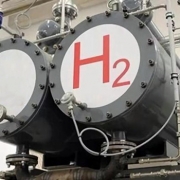What’s the steel material for Hydrogen pipeline?
Hydrogen can be gaseous hydrogen, liquid hydrogen and solid hydrogen according to the state when transportation, among which high-pressure gaseous hydrogen is the most commonly used and environmentally friendly transportation mode at present. Pipeline transportation is the most efficient way for a large throughput and distance occasions can be a long-distance pipeline, also be a short distance distribution pipeline. The long-distance transmission pipeline has high pressure and large diameter, which is mainly used for conveying high-pressure hydrogen between hydrogen production unit and hydrogen station. The latter pipeline is low-pressure and a small diameter is mainly used for the distribution of medium and low-pressure hydrogen between the hydrogen station and end-user. The current cost of long-distance hydrogen pipelines is about $630,000 / km, compared with $250,000 / km for natural gas pipelines, 2.5 times the cost of natural gas pipelines, then comes with the question, how to choose the right material for the transportation of Hydrogen pipeline?
Compared with natural gas, metal materials working in a hydrogen environment for a long time will cause the deterioration of mechanical properties, which is called environmental hydrogen embrittlement. The evaluation of high-pressure hydrogen embrittlement properties of metals is mainly conducted through in-situ hydrogen environment tests, in which materials are directly placed in a hydrogen environment. The types of tests mainly include slow strain rate tensile test, fracture toughness test, crack growth rate test, fatigue life test and disc pressure test. The hydrogen embrittlement can be determined according to No.NASA8-30744 standard and the resistance of materials to hydrogen embrittlement can be evaluated according to ASTM G142-98 comparison of sensitivity test results.
Compared with natural gas pipelines, hydrogen pipelines are different in alloy elements, steel grade, pipe shape and operating pressure due to the limitation of hydrogen embrittlement in the environment. The available materials for natural gas pipelines specified in ASME B31.8-2018 include all the steel pipes in API SPEC 5L. However, in practical engineering, to reduce the wall thickness of pipelines, high-strength steel pipes are generally preferred, and commonly used pipe types include SAWL, SAWH, HFW and SMLS. For hydrogen gas pipeline, a hydrogen environment induced by hydrogen embrittlement occurred, in turn, can lead to pipeline failure, that depends on the steel pipe molding process, weld quality, defect factors such as size, steel strength, so the ASME B31.12-2014 in API SPEC 5 l limited several hydrogens can be used for pipeline steel type, indicating to ban the use of furnace tube welding, pipeline steel specified in the standard can be used in the hydrogen pipe and the maximum allowable pressure as shown in the table below.
| API 5L | X42 | X52 | X56 | X60 | X65 | X70 | X80 |
| Yield strength /Mpa | 289.6 | 358.5 | 386.1 | 413.7 | 488.2 | 482.7 | 551.6 |
| Tensile Strength /Mpa | 413.7 | 455.1 | 489.5 | 517.1 | 530.9 | 565.4 | 620.6 |
| Allowable Pressure, Max | 20.68 | 20.68 | 20.68 | 20.68 | 10.34 | 10.34 | 10.34 |
Alloying elements such as Mn, S, P and Cr can enhance the hydrogen embrittlement sensitivity of low alloy steels. At the same time, the higher the hydrogen pressure and the higher the strength of the material, the more obvious hydrogen embrittlement and hydrogen-induced cracking will be. Therefore, in practical engineering, low steel grade steel tubes are preferred for hydrogen pipelines. ASME B31.12-2014 recommends the use of X42, X52 steel pipes, and stipulates that hydrogen embrittlement, low temperature performance transition, ultra-low temperature performance transition and other issues must be considered.
International standardization organizations include the International Hydrogen Technical Committee (ISO/TC197), the European Industrial Gas Association (EIGA) and the American Society of Mechanical Engineers (ASME) and another organization specifies standards for the production, storage, transportation, testing and use of hydrogen energy, mainly includes ASMEB31.12-2014 “Hydrogen Pipelines”, CGAG-5.6-2005 “Hydrogen Pipeline Systems”, which are suitable for the design of long Hydrogen Pipeline and short distance Hydrogen delivery Pipeline. Hydrogen pipelines are mostly made of seamless steel pipes. The hydrogen pressure is generally 2~10MPa, the diameter of the pipes is 0.3~1.5m, and the pipeline materials are mainly X42, X52, X56, X60, X65, X70, X80 and other low strength pipeline steels. The expected service life is 15~30 years.



اترك رداً
تريد المشاركة في هذا النقاششارك إن أردت
Feel free to contribute!